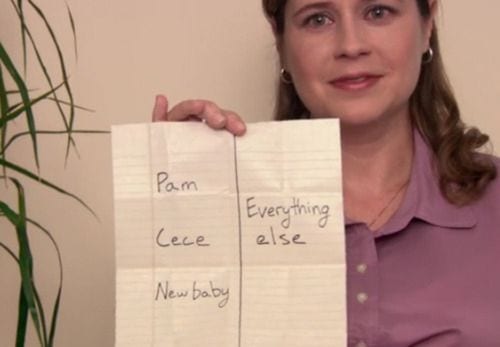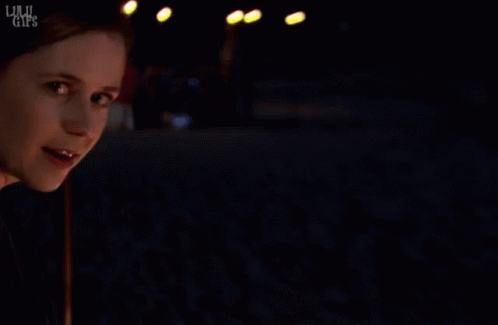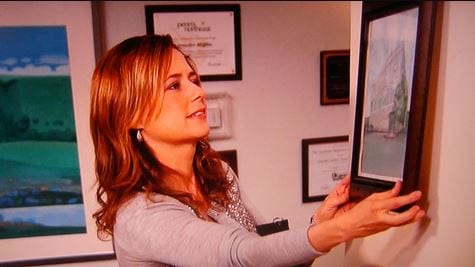There are some pieces of media I simply can’t stop revisiting. And thanks to Netflix, there are some I won’t have to. There’s nothing easier than getting ready for work and pulling up the app on my iPad to distract me as I ineptly slop on mascara. My go-to choice? The ever-quotable and perfectly-fine-fluff mockumentary, The Office.
This was hands-down my favorite sitcom of the mid-00s, and overall it’s aging fairly well. That’s is because while Michael Scott is not a timeless despicable person, he is a timeless ignoramus who we are generally not meant to empathize with. Plans an office workshop around offensive racial stereotypes? He’ll get horribly negative feedback for it, as he should.
However, while Michael’s antics drove the show’s plot (…until he left and The Office morphed into this bizarre indie-fest), Jim and Pam’s relationship almost served as the heart. We were clearly meant to root for them until they inevitably started dating at the end of Season 3, and from there, we were given countless reminders of their strong connection, the fun they had with one another, and how they were so so so happy. Heck, they even dealt with some marital strife in the last year, but pulled through it together because of the strength of their relationship.
“When you’re a kid, you assume your parents are soulmates—my kids are gonna be right about that…I guess it also means that, sometimes, love affairs look different to the people inside them.” —Pam Beesly, “Stress Relief”
The thing is, on rewatch, this “idyllic” relationship has become less and less compelling to me. I’ve already voiced my discomfort in how Jim’s feelings were heavily prioritized over Pam’s in the scripting of their romance, to the point where he very neatly fit into the mold of the Nice Guy. My own distaste for that sexist trope has made rewatching The Office a bit difficult. Yet it wasn’t until I got to the episodes where Pam temporarily moves to New York to take art classes in Season 5 that my discomfort was replaced with something else: rage.
Simply put, Pam Beesly deserved a whole lot better from the writing team. Because even though we were reminded over and over how she had the perfect boyfriend, her story is pretty darn tragic. It’s one of swallowed feelings, swallowed ambition, and sacrifice. She’s quite a realistic character, don’t get me wrong, but what once seemed aspirational now just feels tragic. The fact that the show’s narrative doesn’t seem to recognize that, while fitting, makes it all the worse.

The thing about Pam is that we all know her. We all have a Pam in our life who is with *that guy* that’s obviously unworthy of her, and who’s allowed herself to settle into an almost numbing pattern. That was the Pam we met in Season 1. The Pam who was with Roy, a rather insensitive partner who found their never-ending-engagement cause for humor, and who appreciated her friendship with Jim so he didn’t have to listen to her problems. The Pam who liked to make artwork out of white-out, who wasn’t allowed to take an internship offered by corporate in graphic design, and who got legitimately excited when she received a trophy for having white sneakers.
What’s great is that the show recognized this. Roy was not portrayed as a good romantic match for her, and not just because Jim was there to offer juxtaposition. It was clear that Roy ignored her emotional needs, and even would upset her, only to never be called out on his behavior, and that Pam’s passivity was a problem. His Valentine’s Gift was “the best sex of your life”? Well, I’m sure Pam’s 3-second disappointed glance really made him reconsider.
Jim: Well, what does Roy think about everything?
Pam: I don’t know. I try not to bother him about this kind of stuff.
Jim: You mean, like your thoughts and feelings.
Pam: Yeah.
We’re shown time and time again how she won’t take risks or stand-up for herself. There’s an entire episode devoted to her making the decision that she’s going to assert herself more, and it’s a triumphant moment when she is able to muster the courage to tell a bartender that he served her the wrong beer. She makes out with the man she is actually interested in at the end of Season 2, but isn’t able to commit to that idea, instead saying she was going to go through with her wedding. That’s how foreign going for something she wants that would make her happy is.
There’s a rather natural progression out of this by the show, though, and that’s eminently exciting. It’s true that it’s framed largely around her romantic pursuit of Jim, at least once she and Roy breakup. But it’s more than that too. At the very end of Season 3, after three years of us watching her swallow everything, she finally gets the courage to run across hot coals (to showcase her management potential, of course), and then proceeds to have an emotionally honest conversation with her officemates for the first time in…ever.

We see this positive trend continue in Season 4, though it’s still largely tied to her relationship with Jim. We see her showing more interest in her professional growth, culminating with her getting accepted into a three month art program in New York City. And that’s something truly exciting to watch, given how frustrated she can be at work. After four years, Pam is finally in a relationship where she feels appreciated, and with a partner who supports her pursuing her dreams.
Until he doesn’t. This is where things halt for Pam’s development. Because, you see, this three month art program where she and Jim were an atrocious ~~two hour drive~~ away from one another was such a strain on him, that when she failed a course and needed to stay for another three months to complete the program, she opted not to. Yes, we were told “I really didn’t like it,” except we were never shown that. We were showing a Pam who was happily digging into a new career path, and making new friends. And I don’t believe for one second that Jim’s visible frustrations and jealousy that were made clear to the audience during this time were missed by Pam, the person who knows him better than anyone.
“Summer’s going great. Just spent two hours listening to Michael Clump. I have a weird pain in my left side that I’m convinced is an ulcer. My girlfriend lives in New York and I haven’t seen her in ten days. How’s your summer?” —Jim Halpert, “Weight Loss”
Ten days is literally over 10% of the entire duration of her program. This whole time apart thing is bupkis, though I might just be low-sympathy given that I’m sitting pretty on 750 miles. And yet somehow we’re supposed to be happy that Pam gives up on art school.
Then there’s also the awkward moment where just before she makes that decision, a friend of hers pulls her aside and strongly advises her to stay in New York since that’s where all the opportunities are. “Jim’s in Scranton,” she points out. Yes, in a job where he is shown to be canonically disinterested, though doing rather well for himself despite his condescending “I’m too smart for this” attitude. He works as a salesman, which I have to imagine exist in New York City with a whole lot more frequency than graphic designers in Scranton. Did this never occur to them? I get that we’re limited by Dunder Mifflin Scranton in the narrative, but shouldn’t we have been rooting for them both to get out this whole time?
It’s a moot point though, since Pam decides her life as a receptionist with Jim is worth essentially giving up on her dreams. Sure, we still see her getting to put her drawing skills to use here and there, though it’s treated more like a fun hobby until the end of the show.

Career-wise, once she’s back in Scranton, Pam decides to try and make something more for herself, so when an [admittedly foolish] opportunity comes for her to be a salesman of the new Michael Scott Paper Company, she takes that risk. In the end, she lands herself a job in the same role back at Dunder Mifflin, and all things considered, that’s not nothing.
She and Jim end up getting married and having kids, until Jim decides it’s time for him to pursue his own professional dreams. This means running a sports marketing company in Philadelphia with a terrible business model (that’s worth its own piece). Pam then works overtime to shift schedules and childcare so that he can make his new bi-weekly commute. I should note that this too is ~~two hours away~~. I’d know; I made the drive past Scranton twice in the past couple of months. There’s a town named Waverly right near it that amuses me, but I digress.
This puts a strain on their marriage because Pam had to juggle two very young children, and Jim had to work late at meetings causing him to miss their life events that Pam wasn’t able to perfectly document for him. To solve this, she took interviews for jobs in Philadelphia, but once faced with the reality of the situation, realized she didn’t want to take it. She liked their life in Scranton and didn’t want to uproot their children. Which is…perfectly reasonable? Especially after she dug in to make a career at Dunder Mifflin.
In the end though, when Jim’s shaky start-up moves to Texas, Pam decides to sell their house without telling Jim so that they can make the move there (with no job lined up for herself), saying that she just needed more time to come around to the idea.
Why is the opposite endorsed by the narrative when Pam pursues her professional ambitions than when Jim does? Why do we get countless shots of people looking with pity at Jim when Pam might have to stay in New York for another 90 days, only for the episode to end on the “cheery” note of her quitting and moving back, but when Pam doesn’t want to uproot her family for the sake of a start-up, it’s presented as negative and stagnating? Why is a two-hour drive prohibitive to happiness when it’s for Pam, but when it’s for Jim, it’s acceptable?
Look, I get that Jim and Pam are so incredibly in love that it cures everything. But the discrepancy between the agency they were both accorded by the narrative is striking. Pam’s story is one of continual sacrifice and concessions on her part. It’s really rather heartbreaking, even though she’s able to talk herself into seeing the happiness in each situation. Jim loves her; she owes it to him to give his career a chance. The chance he guilted her out of, even if inadvertently.
It is the most common story in the world for a woman to prioritize a man’s emotional needs and professional ambitions over her own. I just wish it hadn’t been Pam’s story.

